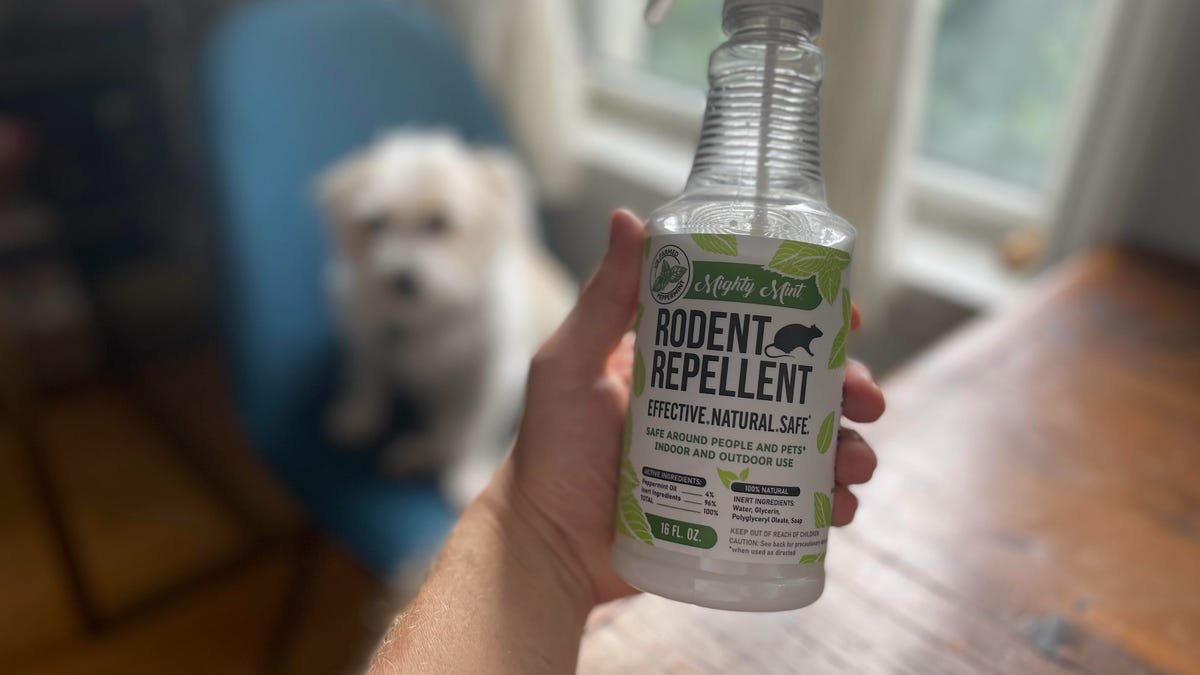
This Pet-Friendly Rodent Spray Is the Only Thing Solved My Mouse Problem
[ad_1]
Updated Nov. 29, 2023 1:34 p.m. PT
Reviews ethics statement

David Watsky Senior Editor / Home and Kitchen
David lives in Brooklyn where he’s logged more than a decade writing about all things edible, including meal kits and meal delivery subscriptions, cooking, kitchen gear and commerce. Since earning a BA in English from Northeastern in Boston, he’s toiled in nearly every aspect of the eats business from slicing and dicing as a sous-chef in Rhode Island to leading complex marketing campaigns for major food brands in Manhattan. These days, he’s likely somewhere trying the latest this or tasting the latest that – and reporting back, of course. Anything with sesame is his all-time favorite food this week.
Expertise Kitchen tech, cookware, small appliances, food innovation, meal delivery and meal kits.

Why You Can Trust CNET
6,0007,0008,0009,00010,00011,00012,00013,00014,00015,000
Sq. Feet of Lab Space
The best way to keep a rodent infestation at bay might surprise you. It certainly surprised me.
David Watsky/CNETIf you’re looking for the best way to repel mice this time of year, you’re not alone. Those pesky rodents love moving into homes for warmth and food during cold winter months. Cute as they may seem, those chip-munching menaces damage doors and moldings, chew through electrical cords and leave unsanitary droppings. In short, mice make terrible roommates for the average homeowner or apartment dweller.
To get rid of mice in my place, I tried a handful of tricks, traps and products. In the end, it was a pet-safe and humane peppermint spray that worked the best. This popular herb wasn’t something I had even considered at the outset, but the spray has kept my home rodent-free without any harm done to the mice or my terrier, Freddie.
Here are the five ways I tried to get rid of mice, my grade for each one, and what finally worked in the end.
Starve them
My first attempt was to remove temptation by overcleaning the kitchen. It worked to some degree, but this infestation required greater firepower.
Sarah Tew/CNETMy first approach was to starve the mice out by sealing up food as best I could and overcleaning the kitchen after every trip. It worked to a degree and I noticed fewer encounters, but my kitchen doubles as a busy meal-kit testing site; try as I might to keep food bits and odors from lingering for more than a few minutes, there’s only so much one can do.
- Cost: None.
- Grade: C-plus.
Humane traps
I caught several mice with these humane traps but not enough to stem the tide coming from next door.
David Watsky/CNETNext, I tried humane traps at the puppy-eyed request of my partner, a dyed-in-the-wool pacifist. These contraptions work by luring mice into the hull with food; when they enter, their weight triggers a door, trapping them inside. Then, it’s on you to release the live mice, preferably far away so that they don’t come back — mice have a famously good sense of smell and direction — and hope they become someone else’s problem.
I set two, and they worked as advertised. I caught a mouse every few nights but it did little to dissuade others from following in their footsteps. Plus, having to relocate a mouse five blocks away every other morning got old fast.
- Cost: $10 (two-pack) on Amazon.
- Grade: B-minus.
Tomcat bait station
Poison bait stations were the least effective method I tried.
TomcatPoison bait traps represented my third attempt. These devices lure mice in with an enticing smell and offer a block of green, edible bait that’s laced with poison. These didn’t work at all. I never found so much as a nibble taken from the bait block. And, the more I thought about it, these posed a far crueler fate for my unwanted intruders than even snap traps. They also mean dead and decaying mice scattered about your home.
Classic snap traps
Snap traps captured a lot of mice but did nothing to keep more from following behind.
David Watsky/CNETSnap traps were the most efficient at stopping the parade of hungry freeloaders. Unlike the trapdoor traps, these mousetraps do kill the mice but they do so with merciful efficiency. The snap traps worked well and I caught more mice than I can count, but still more came. And these devices posed a danger to my curious terrier and could only really be used safely up high on the counter.
- Cost: $9 (6-pack) on Amazon.
- Grade: B.
The winner: Mighty Mint peppermint spray
I sprayed my kitchen’s problem areas with Mighty Mint and haven’t seen signs of mice for a month. That’s $18 well spent.
David Watsky/CNETHaving exhausted most of my options short of an expensive appointment with an exterminator, I resorted to a 16-ounce bottle of peppermint spray for $19 on Amazon. (It’s also available at Target for $10.)
As directed, I sprayed the white peppermint solution near my kitchen baseboards, on the counter behind my toaster oven and in the crevice behind my wall oven. I reapplied the spray every couple of days. You can also use this spray in basements, attics, the engine of your car or any other spots you might not want rodents hanging out.
The peppermint smell was noticeable for the first few hours, but I found it pleasant. The spray went on clear, and there was no damage to the wood floors or marble countertops where I applied it.
Two weeks later (as of when I’m writing this) and I’ve seen no droppings or signs of mice at all — the first time I can say that in months. To be sure it’s working, I left two baited snap traps to gauge whether or not mice have been coming around. Neither one has been triggered.
- Cost: $19 on Amazon.
- Grade: A.
Peppermint spray is safe to use around pets; a big selling point in this house.
David Watsky/CNETIs peppermint rodent spray safe to use around pets and children?
Mighty Mint peppermint spray is made from natural ingredients and is safe to use around dogs and children. But you’ll want to avoid getting in or near your eyes since peppermint oil can cause burning. It also contains soap, so it’s not safe to ingest.
How does peppermint spray repel rodents?
Mice and other rodents hate the smell of peppermint. (Hard to believe, I know.) The spray contains a mix of peppermint oil (4%), water, glycerin, polyglycerol oleate and soap.
What are the uses for peppermint spray?
Peppermint spray is used to repel rodents from indoor spaces like mice and rats. It’s also used to repel insects including mosquitos, spiders, aphids and ants. It can be used in gardens and sprayed on plants to deter invasive pests and vermin.
More pest control tips:
[ad_2]
Source link


